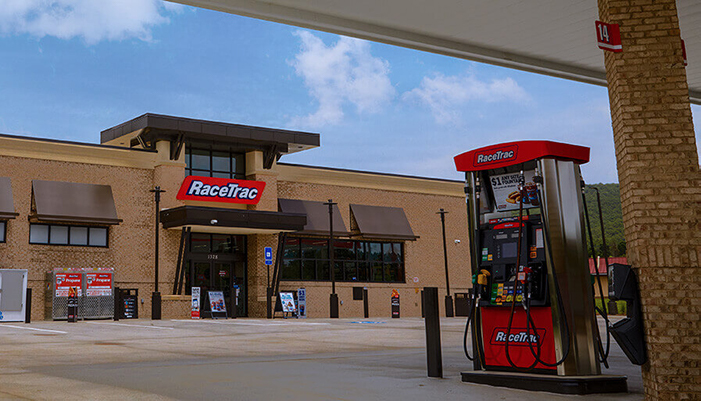A Dramatic Shift from IT Cost Reduction to Value Creation
Hewlett Packard Enterprise
The average convenience store visit at a gas station is 2.5 minutes long. After filling up your tank, you might pop into the bathroom, order a cup of coffee, or grab a packet of chips. In such a short period of time, every moment matters. Did they have what you needed? Could you pay how you wanted? Was a machine broken?
People stop at RaceTrac stores on the way to and from somewhere else, and our goal is to offer a frictionless experience during every 2.5-minute visit.
Serving guests since 1934, family-owned RaceTrac is one of the largest private companies in the US. From our headquarters in Atlanta, we operate more than 750 convenience store locations across 12 southeastern states, as well as companies in wholesale fuel supply (Metroplex Energy) and transportation (Energy Dispatch).

I’ve been with RaceTrac for about 12 years in diverse roles across the organization, starting in project management and moving into and out of finance, analytics, and our food program. Today, I work within IT, where I’m Executive Director of Store Systems and Technologies. As the person accountable for all the technology inside our retail locations, I work to articulate the company’s existing IT challenges and possible solutions, and champion the investment to make it all happen.
Availability Is Everything, and We Were Losing the Game
Two years ago, the challenges in our retail store came down to an inconsistent experience. Different locations had various versions of hardware, software, and firmware, and there was no network resiliency or redundancy. We would sometimes experience a failure (likely due to aging hardware for our POS systems), and all that variability made the failure a lot harder to identify.
That could have any number of ramifications for our guests, such as the availability of loyalty program information, a slowdown of service, and lost sales. It was frustrating for guests and employees alike, and because of the scale of our organization and the number of transactions we complete daily, the downtime greatly impacted the business. In a retail environment, availability is everything. If you have to think about whether a machine will work, you’ve already lost.
Our first step in addressing these issues was to assess our critical failure points. We needed to get this foundation right to set the stage for new technology in the next five to seven years. Without that foundation, we couldn’t execute the next great technology.
A Partner Who Aligns with Our Mission
We ran a few Proofs of Concept (POC) to explore how we could insert redundancy into our environments. We chose HPE because—unlike other vendors we evaluated—they weren’t solely focused on specs or securing a transaction. They got into the trenches with our IT team to understand our current needs and how those needs relate to the mission of our organization, which is to make people’s lives simpler and more enjoyable.
We also chose HPE for their long-term outlook. Their team brought new ideas to the table, presenting a hardware set that would improve reliability today and get us to where we wanted to be in the coming months and years. HPE wants to be a partner in our expansion far beyond this initial project, and they have the complement of products to do it. They also bring their expertise and experience working with numerous other clients before us.
The fewer vendors we have in the ecosystem, the easier it is to manage. It’s more efficient to go to one vendor to solve ten problems; for us, that vendor was HPE.
A Modern Foundation for Future Use Cases
Today, the HPE ProLiant DL160 runs critical components of our retail stores. Anything payment related—like credit card processing and our loyalty platform—flows through this stack, as well as all managerial activities, such as scheduling, timesheets, daily accounting recaps, placing/receiving orders, and communications from the field leadership team. It’s become a large part of our mission-critical infrastructure.

We’re in full deployment mode now and expect to complete this phase of the project near the end of Q1 or early Q2 2023. We eventually plan to migrate even more of our infrastructure, such as fuel components. The HPE ProLiant servers allow us to insert other components should we identify a good business case with some of the partners that HPE is bringing to the table. And once the base layer is complete, we will be ready to start working on more advanced use cases.
For example, this technology refresh includes a more advanced, API-driven and enabled security camera platform. We see this solution set helping us increase our fraud prevention and detection alongside day-to-day operational execution. Their number one purpose of the security cameras is to protect our guests and employees, but if they can help identify where we’ve got an inventory out of stock, that’s a huge deal. If they can help us identify when a machine is down or whether the store missed a delivery, that’s a massive task we can take off our employees’ plates. It will free them to focus on our guests and improve their experience on a personal level rather than logging tickets.
Better Data Visibility Translates to Better Sales
Since starting the pilot in 2021, we’ve had zero hardware failures, significantly reducing our downtime. If something goes down due to a software issue, we can fail over in near-real time to a secondary device without any impact on the business. In most cases, store employees are none the wiser.
Every retailer is facing labor challenges. Working in retail is exhausting, and it becomes even more difficult if we increase the complexity of our operations and ask our employees to do more. Five years ago, our food offerings meant staff had to place some hot dogs on roller grills. Today, they’re making breakfast sandwiches, pizzas, and frying chicken. When a machine goes down, it’s a big ask of our employees to stop what they’re doing to tend to an IT issue. Anything we can do to make their lives a little easier is a top priority, and even though this project falls under IT, it has alleviated the pressure on our in-store teams.
Even though we haven’t completed deployment yet, we’ve already seen an improvement in data gathering and real-time data availability. Getting data in a consistent, timely fashion means we can identify and address a problem much faster. We can draw conclusions from a lack of data, too. If we see pump 19 hasn’t had a contactless transaction in two days, for example, there’s probably an issue that we need to examine.
Before, we didn’t have real-time visibility into our fleet of pumps. When we gained that visibility, we saw that too many of our pumps were down or needed servicing. In this industry, fuel is a big element of a guest visit, but a guest might not tell us if our pump is down—they’ll just go across the street to a competitor. With real-time pump data, we have improved that figure decreasing the number of pump issues open at any one time by 90%, which translates to better sales. We’re now applying that winning approach to everything a customer can see and feel.

An IT Refresh Felt Throughout the Organization
This refresh speaks directly to two of the five pillars of our IT strategy. The first of these is consistency and stability, which we gained through the HPE ProLiant DL160 servers. The other is people development. When IT staff knows the real-life business impacts, they can make better day-to-day decisions, and we’ve seen remarkable growth in our IT team’s responsiveness, accountability, and collaboration.
Technology changes all the time, and I’m proud of how this project has empowered the team to create solutions and strategies as well as make better business decisions, changing the nature of their work daily.







